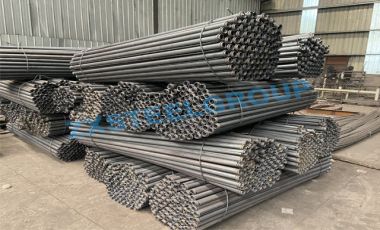
Installing a 39mm friction bolt stabilizer for mine support is a crucial task that requires careful attention to detail and adherence to safety protocols. The following steps will guide you through the installation process:
Gather the necessary equipment: Before you begin, make sure you have all the required equipment and tools readily available. This may include a 39mm friction bolt stabilizer, a drill machine, drill bits, a wrench, a torque wrench, a hammer, personal protective equipment (PPE) such as safety glasses, gloves, and a hard hat, and any other items specified by the manufacturer or site regulations.
Prepare the work area: Clear the area where the stabilizer will be installed, removing any loose debris or obstructions. Ensure that the mine roof or wall is stable and free from any signs of instability or impending collapse. If there are any concerns about safety, consult with a mining engineer or supervisor before proceeding.
Mark the installation points: Use a marking tool to indicate the precise locations where the friction bolt stabilizers will be installed. These points should be determined based on the mine's support plan, which takes into account factors such as the geology of the area, the anticipated loads, and the required spacing between stabilizers.
Drill the holes: With the drill machine and an appropriate drill bit, carefully drill holes at the marked points. The size of the drill bit should correspond to the specifications provided by the manufacturer. Take care to drill the holes to the required depth, ensuring they are clean and free from loose material. Remove any debris from the holes using compressed air or a brush.
Insert the friction bolts: Take the 39mm friction bolts and insert them into the drilled holes. Ensure that the bolts are aligned properly and that the head of the bolt is flush with the mine wall or roof. For each bolt, apply an appropriate amount of torque using a wrench or torque wrench to secure it firmly in place. Follow the manufacturer's recommendations for the specific torque value.
Test the stability: Once all the friction bolts are installed, perform a stability test to ensure they provide adequate support. This may involve conducting load tests or using specialized equipment to measure the rock mass behavior. Consult with a mining engineer or supervisor to determine the appropriate testing method for your specific situation.
Document and monitor: Maintain detailed records of the installation process, including the location of the stabilizers, torque values applied, and any observations or measurements from the stability test. Regularly monitor the performance of the installed stabilizers to detect any signs of movement or deterioration. If any issues arise, take immediate action to address them and consult with experts if necessary.
Remember, installing a friction bolt stabilizer for mine support should only be carried out by trained personnel with experience in underground mining operations. It is essential to prioritize safety at all times, follow the manufacturer's instructions and guidelines, and adhere to any site-specific regulations and protocols.
Address: No. 1738, 17th Floor, No. 1 Mall, Shangdu Road, Zhengdong New District, Zhengzhou City, Henan Province, China
Email: zxminesupport@zxsteelgroup.com
Tel: +86-199 3712 3680
© 2020 ZXSTEELGROUP